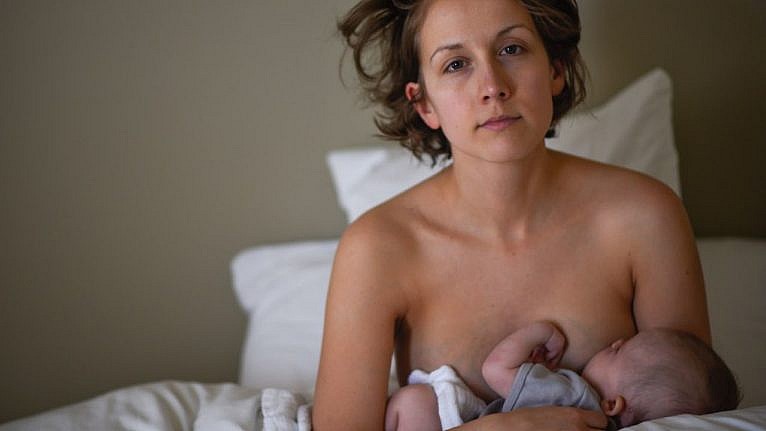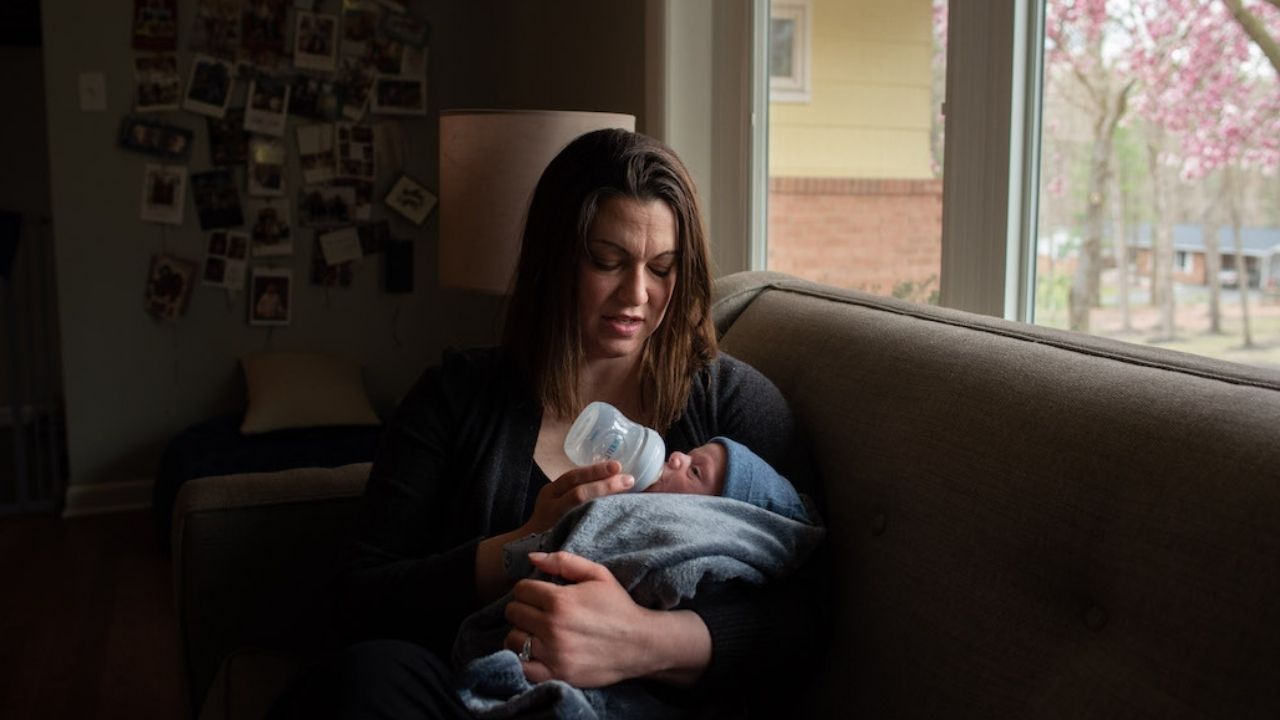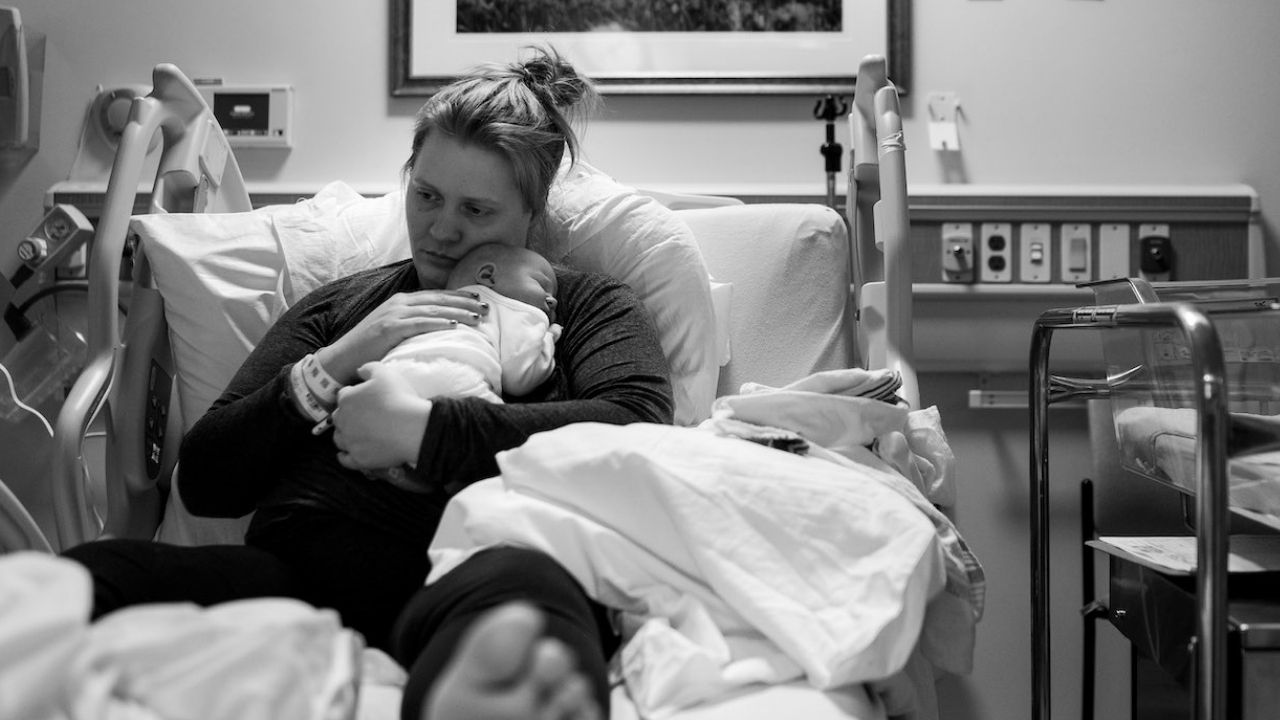After my husband and daughter disappeared behind the heavy steel doors of the psychiatry unit, I felt like I could breathe again. I knew I would be OK.

The author, Ariane Audet, with her newborn, about one week before she was admitted to an in-patient psychiatry unit.
Television and movies always portray pregnancy, birth, and the aftermath as mostly happy events. The discomforts are mild and intermittent: the mom throws up once on the bus, is rushed to the hospital in a cab a few episodes later, yells at her husband, then pushes her baby out with a scream. Afterward, she’s moderately sweaty, but already “so in love,” reclining in an immaculate hospital gown, makeup and hair done.
As for the postpartum period? It’s never part of the picture. As soon as mom is out of the hospital, she resumes life as usual, and the baby disappears from the screen.
The reality of the postpartum period is complex, nuanced and… boring. Sleepless nights go hand in hand with a lingering odor of sour milk. Messy mom buns. Heaps of laundry pile up, and so do unsolicited advice and comments: “Sleep when the baby sleeps! You must be so in love! But don’t hold her too much, you’ll spoil her!”
For many new parents, the months will go by and they’ll see the light at the end of the tunnel. This period will be somewhat challenging, but for the most part, manageable. For others—like me—anxiety and depression will creep into their daily lives, making it impossible to bond, function, and live a full life. Darkness will settle in, and so will intrusive thoughts.
As many as one in four new birthing people in the world experience some type of perinatal mood and anxiety disorder (PMAD). In Canada, 23 per cent of birthing parents say they experience symptoms consistent with postpartum depression (PPD) or postpartum anxiety (PPA). These illnesses frequently go unnoticed and untreated, often with tragic and long-term consequences to both parent and child—which is why it’s important to talk about, especially this week, as we mark World Maternal Mental Health Awareness Day.
Mothers of every culture, age, income level and race can develop a PMAD. Marginalized populations, such as LGBTQ2S+ people, members of the Indigenous community, the Black community and other racialized communities, may experience maternal mental illness at higher rates. Adolescents, mothers with histories of substance use, immigrants, refugees, and individuals with disabilities are also at a higher risk. A new study published in 2020 by the National Institute of Health in the U.S. even suggests that about 5 per cent of women reported persistently high levels of PPD symptoms up to three years after giving birth.
And yet most new parents will have only one postpartum follow-up visit, six weeks after leaving the hospital. That is simply not enough.
This is why maternal mental health awareness matters—and why I started photographing and interviewing postpartum people, as a way to process what happened to me.
During my pregnancy, nothing seemed as important as picking the right crib sheet (organic cotton, no blend) and what kind of birth I wanted (no medication, in a birth centre, groaning in a warm tub.) I religiously attended all the childbirth and breastfeeding classes. Someone might have mentioned PMADs during these, but I don’t remember it. It certainly was not emphasized. The Internet was trying to sell me on the best baby registry app, and my midwives told me about the possible complications during pregnancy and birth, but no one talked about postpartum. I find it remarkable now to think about how focused I was on stretch marks, the right bottle warmer, or DIY padsicles, and not on caring for my own mental health.
I know I was asked about my mental health at least once (I have a history of anxiety and suicidal ideation), but no one ever followed up with me. “We don’t want to scare future moms,” I was told over and over again. A note was put in my chart about past sexual assaults, and that was it.
Everything in our reproductive health care system is built around keeping the baby safe and healthy. It means caring for the vessel—the person gestating the baby—during pregnancy, but once the baby’s out, gone is the attention provided to the birthing person. Pregnant people have about 16 prenatal visits during their pregnancies, versus one follow-up during the postpartum months. A lot of it has to do with the history of gynecology and obstetrics—rooted in sexism and racism—and how much it costs to care: blanket advice and lab tests are faster to implement. They don’t demand too much time and are cost-efficient.
I remember having a panic attack every time I opened a bill from my midwives’ practice. I was a Canadian from Montreal who’d recently moved to the U.S., and I was not used to the labyrinthine American healthcare system, or the absence of maternity leave. I had just finished my Ph.D., and then one month after putting all my life in a tiny rental car to cross the border and join my husband, I became pregnant. If I wanted a full year with my baby, like all my Canadian friends and family, I knew I would have to put my career (and paycheck) on hold. I was lucky that my husband could support me, but my pride took a hit. I had moved to his country and left everything behind for love’s sake.
I rationalized my isolated situation by telling myself I loved solitude. I believed that I could still write that book I’d vowed to finish. After all, babies nap, right? I’ll have all the time in the world to be creative, right? Obviously, I had no idea.
The birth was difficult but uneventful. I ended up in the hospital with an epidural, cared for by a nice nurse called Geneviève, who actually spoke French and was also a Montrealer—an amazing coincidence, considering I was 1,000 miles away from home.
I laboured for 18 hours, pushed for less than 30 minutes, and then they put my daughter on my stomach.
She was beautiful, healthy, pink and screaming.
And I felt nothing.
As they stitched me up, I watched this squirmy alien being wiped off by gloved hands. “I hope breastfeeding won’t be too hard,” I heard one nurse say. “With inverted nipples like yours…”
Breastfeeding did indeed turn out to be awful. I worked hard to make it work, the same way I had done everything in life: by pushing through. I was heavily sleep-deprived and wouldn’t give my newborn a life-saving pacifier, fearing she would develop nipple confusion.

Photo: Ariane Audet, Faces of Postpartum.
Motherhood was indeed hard, as everyone had told me it would be. I assumed my feelings of despair and utter panic must be part of the deal, too.
Months went by and blurred into each other. I couldn’t bear having people over, asking to hold my newborn as if she was some coveted prize. Every time she was in somebody else’s arms, I’d go into another room for fear of having a panic attack.
Every paediatrician appointment felt like a test: “How many wet diapers? Does she sleep on her back? Not in your bed, right?”
Driving induced an intense fear of dying, and so did walking down the stairs with my baby in my arms, or taking a knife out of the drawer, or even just falling asleep at night (“I will never wake up”). To live became a threat.
Then one afternoon, four and half months after her birth, it happened. My husband was upstairs with our daughter in her nursery. He was changing her, and they were both laughing. As I sat on the couch, watching TV and folding tiny onesies, a voice in my head said, “Listen to them: They’re happy. They don’t need you. Just die already.”
Days before that event, I had found a therapist. Call it providence, but she had given me her phone number, urging me to text if anything happened. Something had definitely happened.
The following week, the intrusive thoughts came rushing at me, more frequently and more violently. My therapist and I tried different coping mechanisms, but the thoughts wouldn’t leave me alone, and no matter how many walks outside or deep breathing exercises I did, my brain kept telling me I should kill myself. “We have to stop the boulder from rolling down the hill and destroying everything,” my therapist told me.
After four days of trying to fight the beast on my own, I finally gave in. This life was no longer safe for my daughter or me: It was time to go to the hospital.
At the time (2017), there was only one perinatal psychiatry inpatient unit in the U.S., based at the University of North Carolina. One. With five beds. There are four million birthing people each year in the U.S., and one in seven people will experience PPD in the year after giving birth. That’s a lot of people who would benefit from a bed.
By some miracle, I landed one.
Four days after my first suicidal ideation, I drove the five hours that separate my house in Virginia to UNC, sobbing uncontrollably every mile of the way.
One thing people need to understand about psychiatric wards is that it’s not like in the movies. No one wants to keep you there forever to experiment with strange drugs. They do tell you not to bring shoes with laces, and you have to floss in front of the nurses’ station because you could use the thread to hang yourself. Upon arrival, they pat your clothes to make sure you haven’t hidden a razor blade in the hem of your pants, but for the most part, everyone there simply wants to make sure you are safe and cared for.
I had anticipated the moment my husband and daughter would leave me throughout the whole drive. But when they disappeared behind the heavy steel door of the psychiatry unit that evening, I felt like I could breathe again. Professionals were in charge now. I would be OK.
Because it’s one of a kind, the Perinatal Psychiatry Inpatient Unit at UNC only hosts new birthing people in an environment that tries to mimic home: babies cannot sleep on the ward (the patient’s sleep is first priority), but frequent visitations from the family are strongly recommended. There is a hospital-grade pump in each private room, and you meet with one team of caring providers every morning to adjust your meds and talk about your day. When COVID isn’t raging, group therapy is mandatory, and you have the option of individual sessions if you’d like. There is yoga every other day, and after you’re deemed stable enough, you can even go for walks (with a nurse as a chaperone).
I remember the other four moms like it was yesterday. We’d sometimes eat breakfast together if they were feeling OK. One had severe psychosis while another dealt with PTSD; her birth had triggered past traumas, and she had to live with constant flashbacks from her childhood. During group sessions, we talked about the toughest topics. We’d talk about how we had visions of dropping our child at the bottom of the stairs or how uncomfortable wiping our baby’s vulvas was after surviving childhood abuses. Everyone was committed not to repeat the trauma we had endured, or to enact the visions that were flooding our brains, but for most of us, it was a relentless job. Then, during visiting hours, our children would play together, and we’d all look at each other as if this had all been a dream.
The unit had the advantage of teaching a lot of skills in a very short timeframe. It encouraged us to ditch the apps on our phone, trust our gut, and prioritize our sleep—at least four to five consecutive hours every night. (This much sleep is a rarity for many new parents, but in some cases, it’s the only path to recovery.)
As the days went by, I grew stronger and more confident in my ability to care for myself and my baby. A week after I was admitted, they released me with a hug, a grocery list of self-care things to do, and the prescription bag with a well-balanced cocktail of chemicals that is still helping me to this day: antidepressants, a sleep-aid, and anxiety meds. For someone who had always been reluctant to take medicine, it was a lesson in humility.
My stay in the psychiatric unit hasn’t fixed everything—far from it. But I felt fortified by their belief that I could thrive. I learned that becoming a mom is a process—it’s called matrescence. Yes, motherhood is hard. It has a learning curve, but the curve does not, under any circumstances, have to be excruciatingly painful. And it shouldn’t be lonely, isolating, debilitating, and destructive.
I’ve always said that Faces of Postpartum, the storytelling and advocacy project I founded, was born one night on the unit at UNC, as I laid on the uncomfortable hospital mattress, anxious and unable to sleep. This genesis had always been so clear, so obvious that, for some reason, I’ve never felt the need to fact-check the exact date of FPP’s origins. But when I look back through my records, it turns out I had purchased the domain name six days before I drove myself to the hospital.
The chronology doesn’t really matter now. This project was the beginning of my healing process—a sure sign that I was on the right path. I did not create Faces of Postpartum because I had finally gotten help: I created it because I thought it was the only thing left to do in order to survive.

Photo: Ariane Audet, Faces of Postpartum.
I didn’t want people to associate the word “postpartum” solely with mental illnesses. I wanted it to conjure, and to include, all the things no one had ever told us about: physiological changes; sleep realities; NICU stays; feeding by chest, bottle or tube; birth trauma; community; and self-care (the real kind, not just a bubble bath). I wondered what kind of postpartum period adoptive or foster parents went through, what parents who suffered a loss or stillbirth did when they came back home empty-handed, and what struggles transgender men and same-sex parents underwent after the arrival of their children.
I longed for a village, so I created one of my dreams.
At first, I knocked on my family and friends’ doors, hoping they would agree to have their portrait taken and talk to me about their postpartum period, whether they were still in it, or they’d given birth 60 years prior. More and more people agreed to welcome me into their intimate space as I asked how bringing a baby home affected their mood, marriage, and spirituality. I took more photographs of badass parents than I could have ever dreamed of. One year went by. Faces of Postpartum grew, and so did my desire to have another child, something I could have never imagined in a million years.
We welcomed our second daughter with a planned home birth. The postpartum period was still difficult, but I had more tools in my toolbox this time. I came prepared: a freezer filled with homemade meals, a kick-ass birthing team, and my therapist’s and psychiatrist’s phone numbers in hand. Most important, I was not alone. We hired a postpartum doula to help out (because my family lived too far away). I held and slept with my baby for as long as I wanted, and got my APNO cream for cracked nipples ahead of time. I talked to my therapist once a week, took my paediatrician’s advice with a grain of salt, and remained on my meds throughout my whole pregnancy and beyond.
I recognized the privileges I’d had, and the changes I’d been able to make to protect myself and my family, which crystalized my choice to be a vocal advocate for others. FPP eventually became a non-profit and advocacy organization, on top of a documentary project. I recognize myself in each story I gather, interview I conduct, and person I photograph. Every single one of them is unique and part of this greater alliance that we call parenthood.
Postpartum people deserve better; families deserve better. We deserve a network of support. A global campaign like World Maternal Mental Awareness Month not only raises awareness, influences policies, and changes attitudes towards perinatal mood disorders: it also saves lives.
Last month, the Maternal Mental Health Act, which sought to expand treatment, supports and awareness of perinatal mental health disorders, was voted down by the Ontario legislature, eclipsed by the debate over paid sick leave and the province’s highest COVID numbers yet. But when our society doesn’t address these systemic issues, we send the message that it’s OK for a mother’s lifelong trauma to carry, and for families to implode. Canada doesn’t even have one mother and baby psychiatric unit, and I think it’s nothing but shameful.
I know first-hand the collateral damage that mental illness and PMADs can cause. If I hadn’t sought and received proper maternal mental health care, I don’t know what would have happened to me.
Actually, maybe I do know: I would not be here today.
FILED UNDER: long read Maternal health Mental health Postpartum postpartum anxiety Postpartum care Postpartum depression
Source link : https://www.todaysparent.com/baby/postpartum-care/my-stay-on-a-psychiatric-ward-for-postpartum-depression-inspired-a-new-career












